You have an Azure Synapse Analytics dedicated SQL pool named Pool1 and an Azure Data Lake Storage Gen2 account named Account1.
You plan to access the files in Account1 by using an external table.
You need to create a data source in Pool1 that you can reference when you create the external table.
How should you complete the Transact-SQL statement? To answer, select the appropriate options in the answer area.
NOTE: Each correct selection is worth one point.

You have an Azure subscription that contains an Azure Synapse Analytics dedicated SQL pool named Pool1. You have the queries shown in the following table.

You are evaluating whether to enable result set caching for Pool1. Which query results will be cached if result set caching is enabled?
You have a trigger in Azure Data Factory configured as shown in the following exhibit.
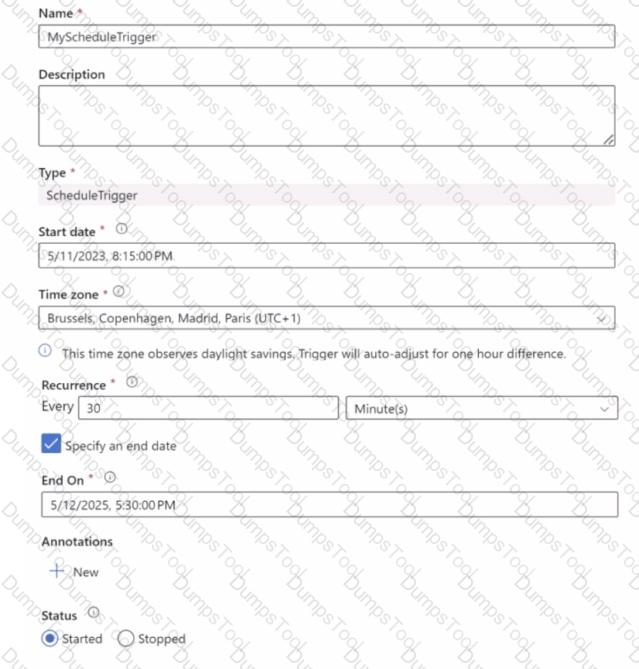
Use the drop-down menus to select the answer choice that completes each statement based upon the information presented in the graphic.

You are building an Azure Synapse Analytics dedicated SQL pool that will contain a fact table for transactions from the first half of the year 2020.
You need to ensure that the table meets the following requirements:
Minimizes the processing time to delete data that is older than 10 years
Minimizes the I/O for queries that use year-to-date values
How should you complete the Transact-SQL statement? To answer, select the appropriate options in the answer area.
NOTE: Each correct selection is worth one point.
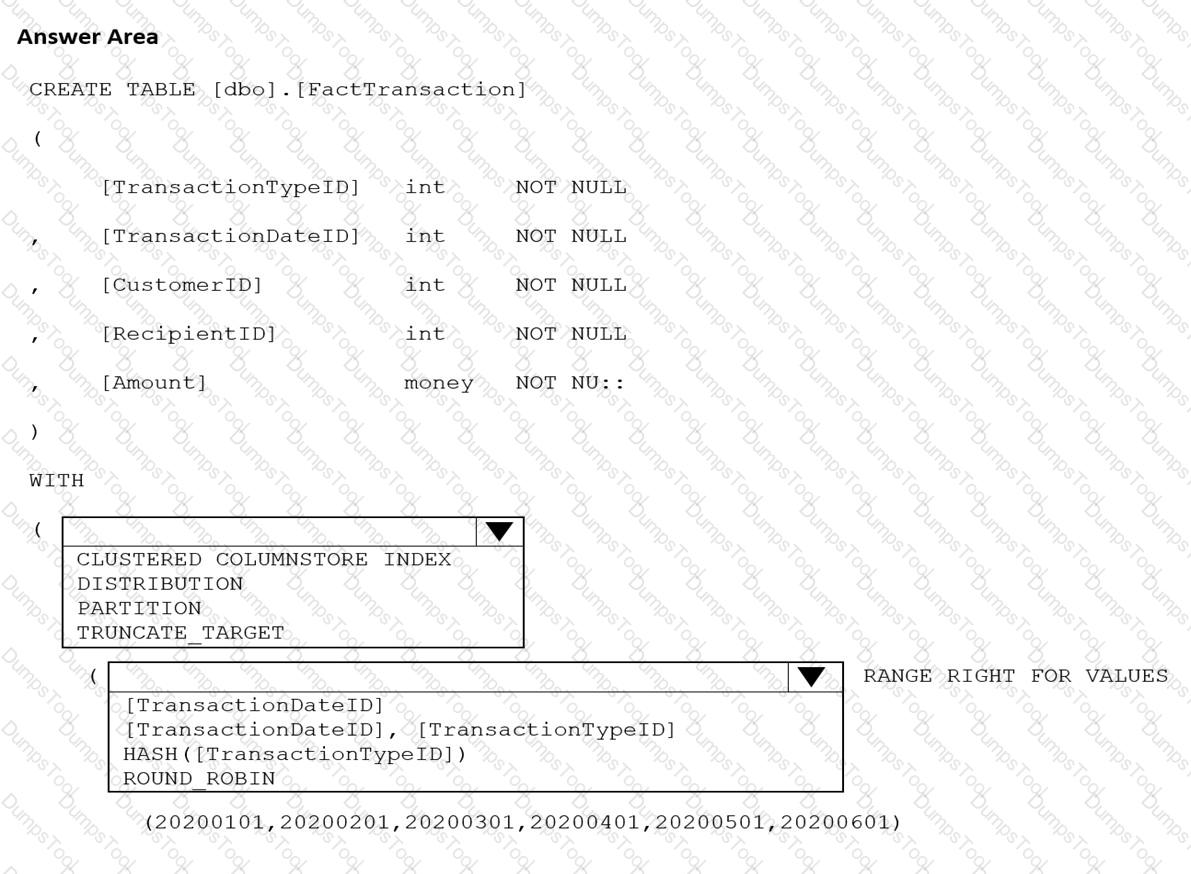
You are designing an application that will store petabytes of medical imaging data
When the data is first created, the data will be accessed frequently during the first week. After one month, the data must be accessible within 30 seconds, but files will be accessed infrequently. After one year, the data will be accessed infrequently but must be accessible within five minutes.
You need to select a storage strategy for the data. The solution must minimize costs.
Which storage tier should you use for each time frame? To answer, select the appropriate options in the answer area.
NOTE: Each correct selection is worth one point.
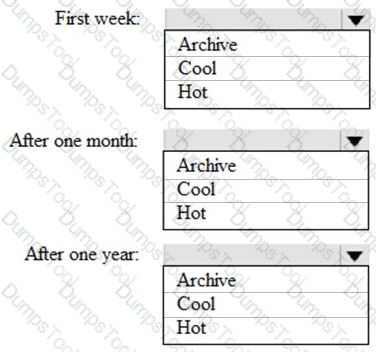
You have an Azure subscription that contains an Azure Cosmos DB analytical store and an Azure Synapse Analytics workspace named WS 1. WS1 has a serverless SQL pool name Pool1.
You execute the following query by using Pool1.
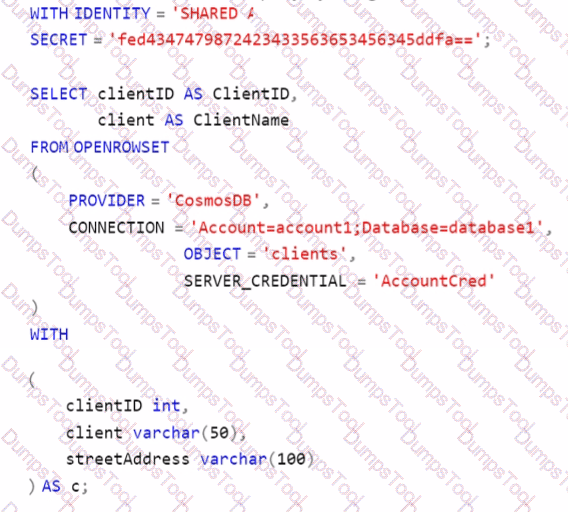
For each of the following statements, select Yes if the statement is true. Otherwise, select No.
NOTE: Each correct selection is worth one point.

Note: This question it part of a series of questions that present the same scenario. Each question in the series contains a unique solution that might meet the stated goals. Some question sets might have more than one correct solution, while others might not have a correct solution.
After you answer a question in this section, you will NOT be able to return to it. As a result, these questions will not appear in the review screen.
You have an Azure Data Lake Storage account that contains a staging zone.
You need to design a daily process to ingest incremental data *rom the staging zone, transform the data by executing an R script and then insert the transformed data into a data warehouse in Azure Synapse Analytics.
Solution: You use an Azure Data Factory schedule trigger to execute a pipeline that executes a mapping data flow, and then inserts the data into the data warehouse.
Does this meet the goal?
You are implementing Azure Stream Analytics windowing functions.
Which windowing function should you use for each requirement? To answer, select the appropriate options in the answer area.
NOTE: Each correct selection is worth one point.

You have an Azure Data Lake Storage Gen2 account that contains a container named container1. You have an Azure Synapse Analytics serverless SQL pool that contains a native external table named dbo.Table1. The source data for dbo.Table1 is stored in container1. The folder structure of container1 is shown in the following exhibit.
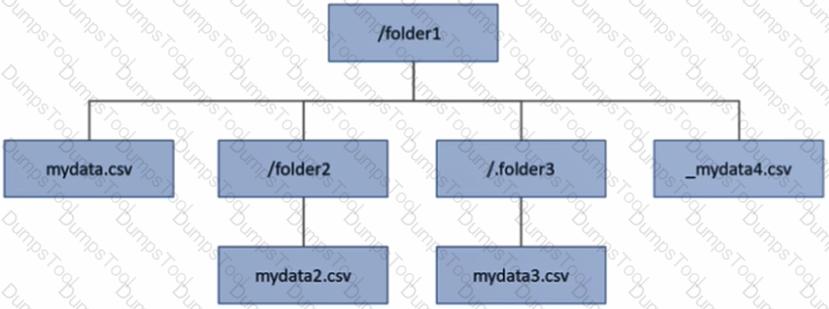
The external data source is defined by using the following statement.

For each of the following statements, select Yes if the statement is true. Otherwise, select No.
NOTE: Each correct selection is worth one point.

You have an Azure Databricks workspace that contains a Delta Lake dimension table named Tablet. Table1 is a Type 2 slowly changing dimension (SCD) table. You need to apply updates from a source table to Table1. Which Apache Spark SQL operation should you use?
You use Azure Data Lake Storage Gen2 to store data that data scientists and data engineers will query by using Azure Databricks interactive notebooks. Users will have access only to the Data Lake Storage folders that relate to the projects on which they work.
You need to recommend which authentication methods to use for Databricks and Data Lake Storage to provide the users with the appropriate access. The solution must minimize administrative effort and development effort.
Which authentication method should you recommend for each Azure service? To answer, select the appropriate options in the answer area.
NOTE: Each correct selection is worth one point.
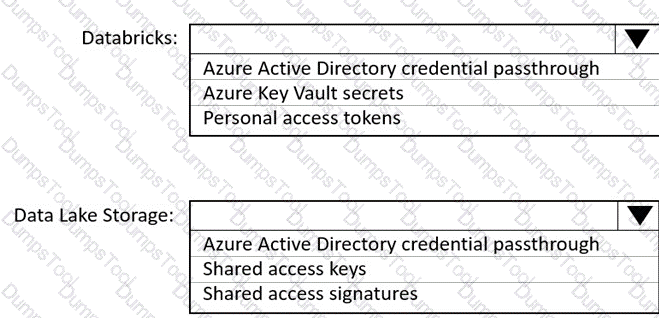
You manage an enterprise data warehouse in Azure Synapse Analytics.
Users report slow performance when they run commonly used queries. Users do not report performance changes for infrequently used queries.
You need to monitor resource utilization to determine the source of the performance issues.
Which metric should you monitor?
You plan to create an Azure Data Lake Storage Gen2 account
You need to recommend a storage solution that meets the following requirements:
• Provides the highest degree of data resiliency
• Ensures that content remains available for writes if a primary data center fails
What should you include in the recommendation? To answer, select the appropriate options in the answer area.
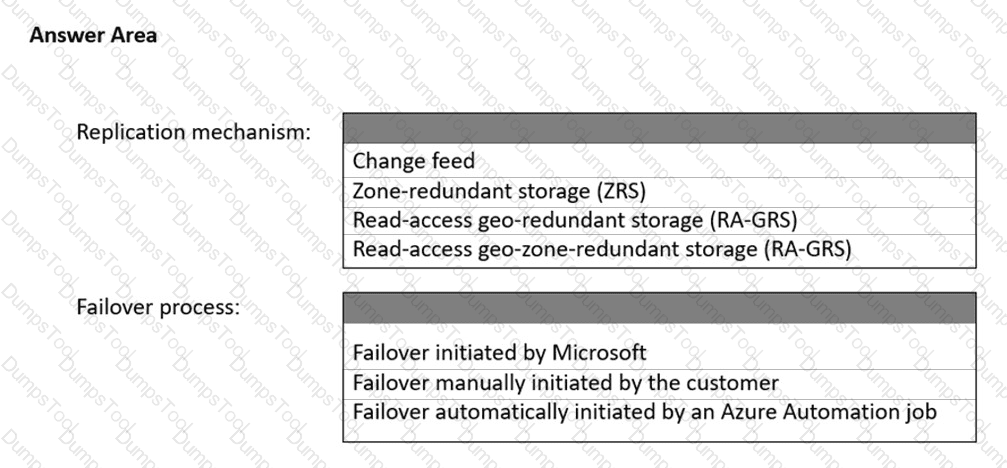
You have files and folders in Azure Data Lake Storage Gen2 for an Azure Synapse workspace as shown in the following exhibit.

You create an external table named ExtTable that has LOCATION='/topfolder/'.
When you query ExtTable by using an Azure Synapse Analytics serverless SQL pool, which files are returned?
You have an Azure Stream Analytics query. The query returns a result set that contains 10,000 distinct values for a column named clusterID.
You monitor the Stream Analytics job and discover high latency.
You need to reduce the latency.
Which two actions should you perform? Each correct answer presents a complete solution.
NOTE: Each correct selection is worth one point.
You plan to implement an Azure Data Lake Gen2 storage account.
You need to ensure that the data lake will remain available if a data center fails in the primary Azure region.
The solution must minimize costs.
Which type of replication should you use for the storage account?
You are planning a streaming data solution that will use Azure Databricks. The solution will stream sales transaction data from an online store. The solution has the following specifications:
* The output data will contain items purchased, quantity, line total sales amount, and line total tax amount.
* Line total sales amount and line total tax amount will be aggregated in Databricks.
* Sales transactions will never be updated. Instead, new rows will be added to adjust a sale.
You need to recommend an output mode for the dataset that will be processed by using Structured Streaming. The solution must minimize duplicate data.
What should you recommend?
You have an Azure subscription that contains an Azure Blob Storage account named storage1 and an Azure Synapse Analytics dedicated SQL pool named Pool1.
You need to store data in storage1. The data will be read by Pool1. The solution must meet the following requirements:
Enable Pool1 to skip columns and rows that are unnecessary in a query.
Automatically create column statistics.
Minimize the size of files.
Which type of file should you use?
You are building an Azure Stream Analytics job that queries reference data from a product catalog file. The file is updated daily.
The reference data input details for the file are shown in the Input exhibit. (Click the Input tab.)
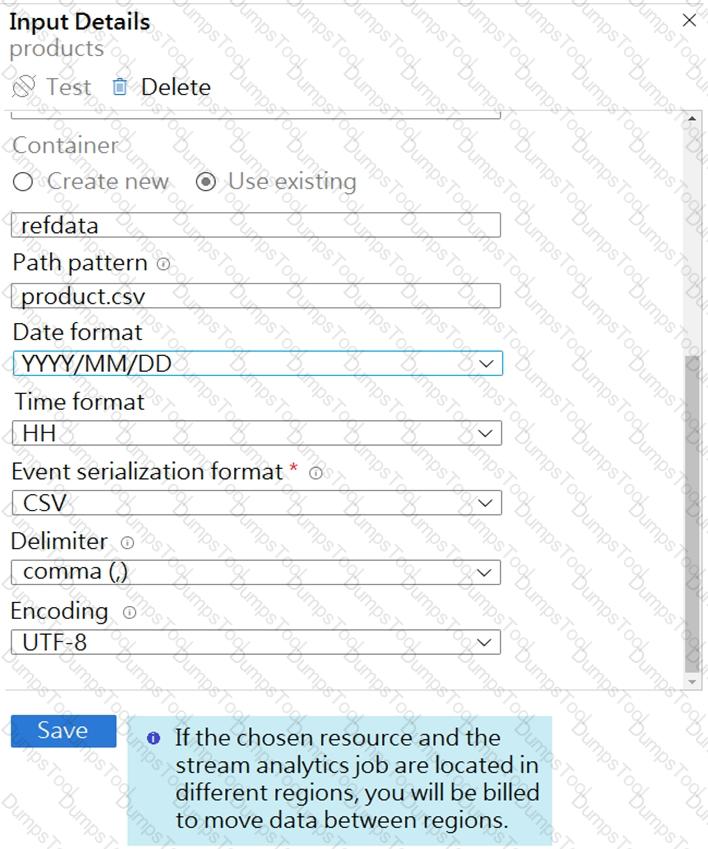
The storage account container view is shown in the Refdata exhibit. (Click the Refdata tab.)

You need to configure the Stream Analytics job to pick up the new reference data.
What should you configure? To answer, select the appropriate options in the answer area.
NOTE: Each correct selection is worth one point.
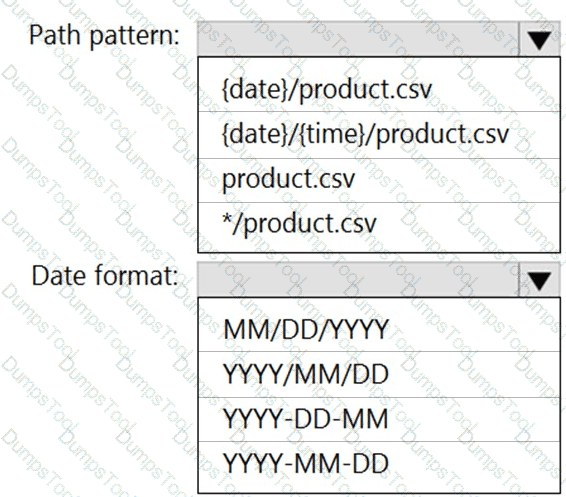
You plan to use an Apache Spark pool in Azure Synapse Analytics to load data to an Azure Data Lake Storage Gen2 account.
You need to recommend which file format to use to store the data in the Data Lake Storage account. The solution must meet the following requirements:
• Column names and data types must be defined within the files loaded to the Data Lake Storage account.
• Data must be accessible by using queries from an Azure Synapse Analytics serverless SQL pool.
• Partition elimination must be supported without having to specify a specific partition.
What should you recommend?
You need to design a data retention solution for the Twitter feed data records. The solution must meet the customer sentiment analytics requirements.
Which Azure Storage functionality should you include in the solution?
You need to design a data storage structure for the product sales transactions. The solution must meet the sales transaction dataset requirements.
What should you include in the solution? To answer, select the appropriate options in the answer area.
NOTE: Each correct selection is worth one point.

You need to design a data ingestion and storage solution for the Twitter feeds. The solution must meet the customer sentiment analytics requirements.
What should you include in the solution? To answer, select the appropriate options in the answer area
NOTE: Each correct selection b worth one point.

You have an Azure Synapse Analytics dedicated SQL pool that contains a table named Sales.Orders. Sales.Orders contains a column named SalesRep.
You plan to implement row-level security (RLS) for Sales.Orders.
You need to create the security policy that will be used to implement RLS. The solution must ensure that sales representatives only see rows for which the value of the SalesRep column matches their username.
How should you complete the code? To answer, select the appropriate options in the answer area.
NOTE: Each correct selection is worth one point.
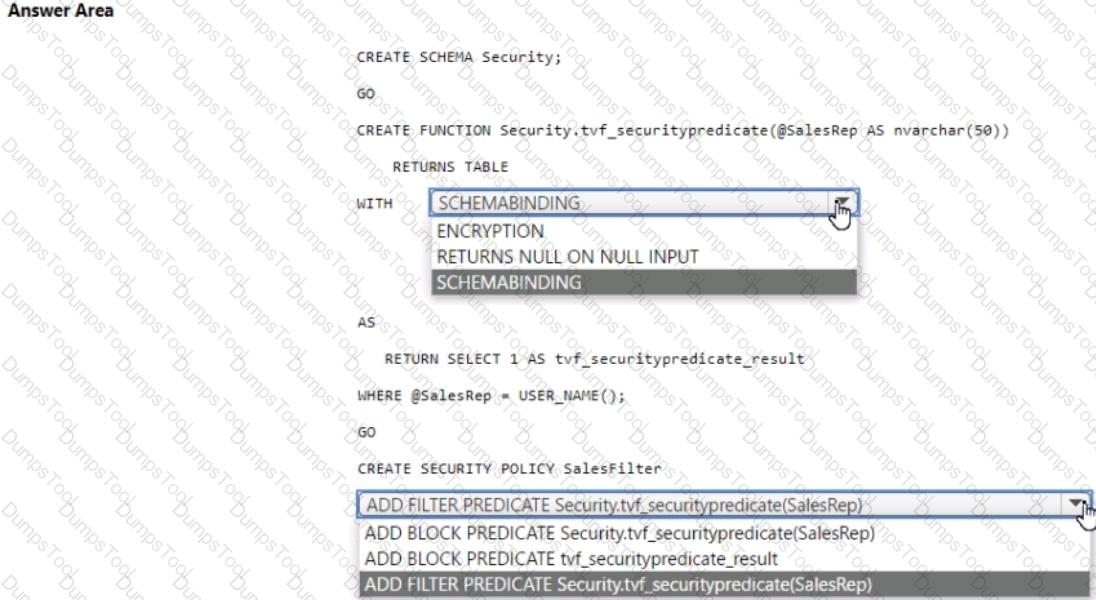
You need to implement an Azure Synapse Analytics database object for storing the sales transactions data. The solution must meet the sales transaction dataset requirements.
What solution must meet the sales transaction dataset requirements.
What should you do? To answer, select the appropriate options in the answer area.
NOTE: Each correct selection is worth one point.

You need to implement versioned changes to the integration pipelines. The solution must meet the data integration requirements.
In which order should you perform the actions? To answer, move all actions from the list of actions to the answer area and arrange them in the correct order.
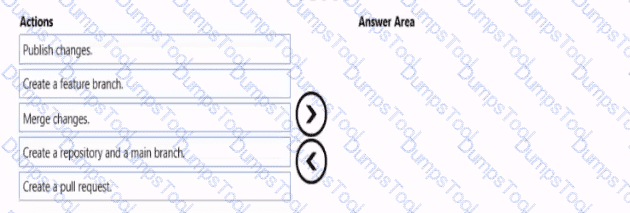
You need to integrate the on-premises data sources and Azure Synapse Analytics. The solution must meet the data integration requirements.
Which type of integration runtime should you use?
You need to ensure that the Twitter feed data can be analyzed in the dedicated SQL pool. The solution must meet the customer sentiment analytics requirements.
Which three Transaction-SQL DDL commands should you run in sequence? To answer, move the appropriate commands from the list of commands to the answer area and arrange them in the correct order.
NOTE: More than one order of answer choices is correct. You will receive credit for any of the correct orders you select.

You need to design an analytical storage solution for the transactional data. The solution must meet the sales transaction dataset requirements.
What should you include in the solution? To answer, select the appropriate options in the answer area.
NOTE: Each correct selection is worth one point.
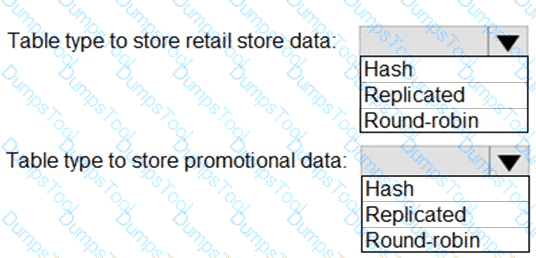
You need to design the partitions for the product sales transactions. The solution must meet the sales transaction dataset requirements.
What should you include in the solution? To answer, select the appropriate options in the answer area.
NOTE: Each correct selection is worth one point.
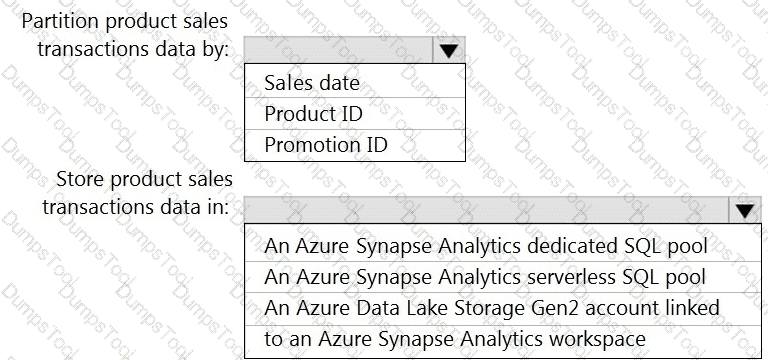
You need to implement the surrogate key for the retail store table. The solution must meet the sales transaction
dataset requirements.
What should you create?
What should you do to improve high availability of the real-time data processing solution?
What should you recommend to prevent users outside the Litware on-premises network from accessing the analytical data store?
Which Azure Data Factory components should you recommend using together to import the daily inventory data from the SQL server to Azure Data Lake Storage? To answer, select the appropriate options in the answer area.
NOTE: Each correct selection is worth one point.
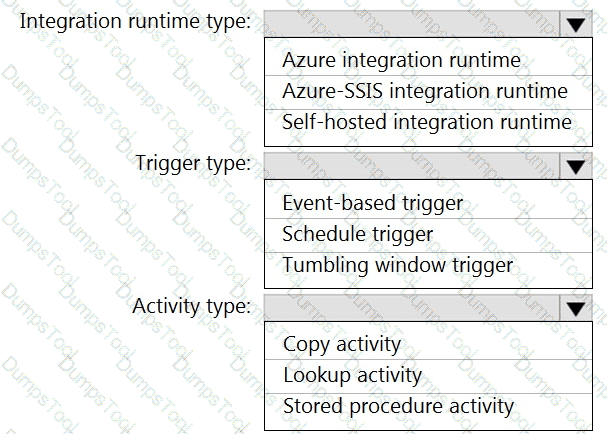
What should you recommend using to secure sensitive customer contact information?